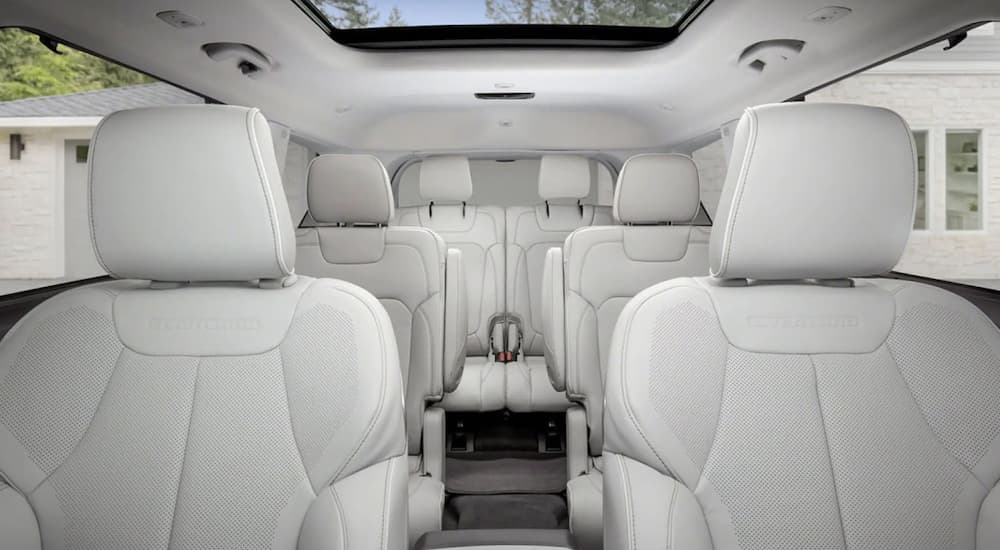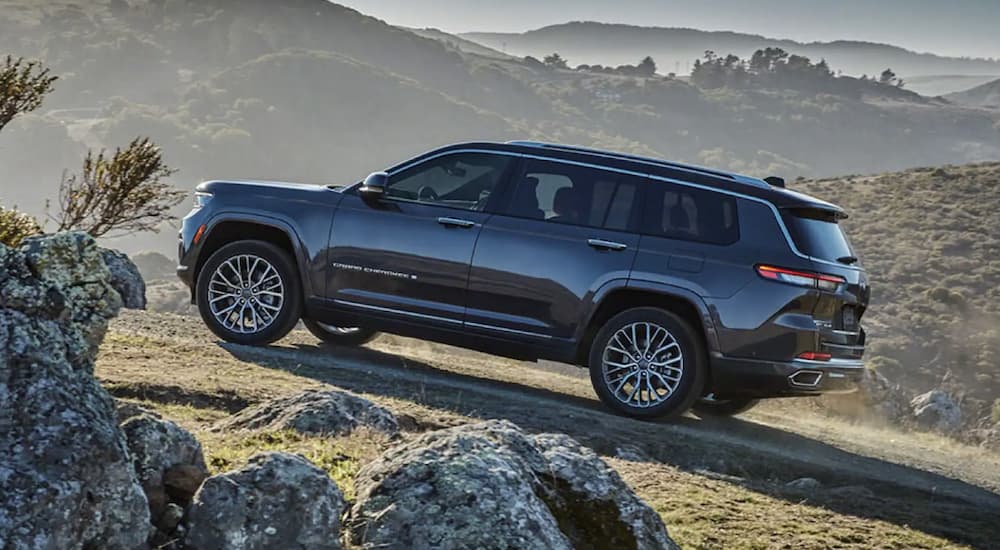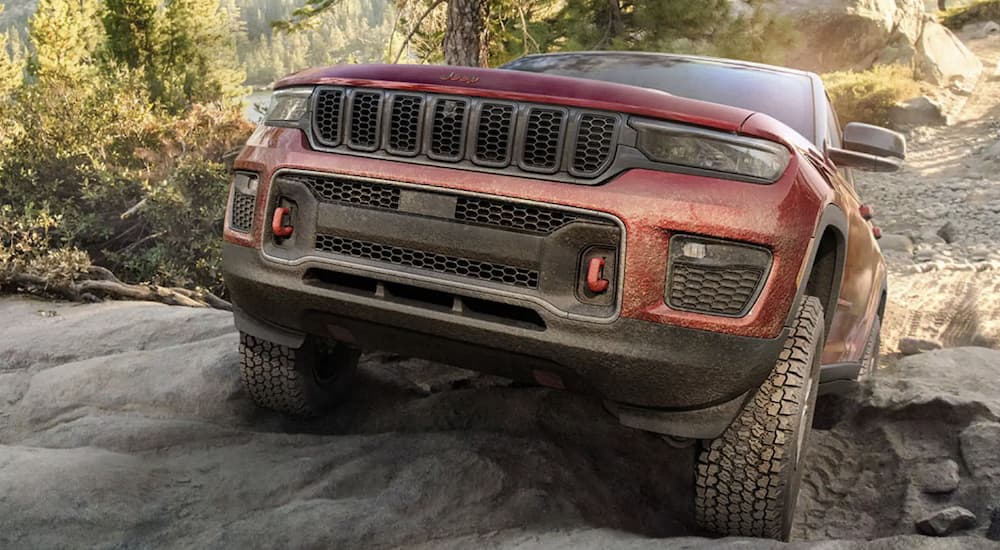It’s always an interesting time to sit down and reflect on what makes your favorite vehicles so great. Do you have a favorite feature? Favorite brand? Since you’re here, you’re likely currently interested in one brand and one vehicle: the 2022 Jeep Grand Cherokee. If you’ve heard claims in the past that the Grand Cherokee is a vehicle worthy of your hard-earned cash, then you, my friend, have heard correctly. Why is this, you may be asking? Truthfully, there’s no single answer, and the appeal of the Grand Cherokee can’t be wrapped up in one sentence. This is why I’ve curated a list of my favorite features you’ll find in the latest Grand Cherokee. Some of these features come standard for you drivers out there who want to stick with the base model, but some will require a bit of extra expenditure.
How do you begin looking into the best of the best? For starters, I considered what not only would I want in a vehicle, but what the average driver would want too. Fortunately for us, the Jeep Grand Cherokee checks all of the boxes. To truly experience a vehicle requires both touch and feel. From the materials of your cabin and the cushiness of your seat to the fluidity of your infotainment center’s software and the clarity of your audio setup, there is a lot that goes into curating the ultimate driving experience. Here are some of the features I feel truly enhance the 2022 Grand Cherokee.
#5 McIntosh Premium Audio
I wanted to start with a rather unique one, the available McIntosh premium audio setup. How are they unique, you ask? The premium audio system you can fit inside of your Grand Cherokee is leagues above nearly every other audio setup in the automotive market. How does it achieve this? An absurd number of speakers is how.
Some vehicles come with four-speaker audio systems, some with six, and more premium options offer eight to twelve speakers. With the McIntosh audio setup inside of the Grand Cherokee, however, Jeep fits nineteen high-grade speakers throughout your cabin. These speakers are driven through 950W of power and are spread across seventeen audio channels for a far more dynamic experience. Not only will this fill the cabin with clean and clear audio, but the included 10-inch subwoofer means you can crank the bass all you want.

#4 Two Premium Seats
What’s not to love about comfort? Jeep feels this way, too, especially considering the type of seats you can add to your Grand Cherokee. Firstly, the materials available to you for your seats include cloth and leather, the latter I recommend to anyone who wants to customize the appearance of their Grand Cherokee. As for the seats, you can opt for an incredible 16-way power-adjustable driver’s seat. These aren’t just any seats – these seats will massage your lower back while acting as lumbar support. It’s going to be hard not to find an ideal position you feel comfortable sitting in, and the extra lumbar support is much appreciated for anybody who has a bad back, but I’ll spare you the time, so you don’t have to listen to me ramble about back pain.
So, now that I’ve established your driver’s seat can be the pinnacle of comfort, how about the passenger sitting next to you? Far too often, I see vehicle manufacturers give the driver’s seat a plethora of posture positions, yet the person sitting beside them is relegated to an unappealing manually-adjustable chair. Not with the Grand Cherokee, however! With the Grand Cherokee, the passenger to your right can enjoy the luxury of an identical 16-way power-adjustable seat, plus built-in massaging and lumbar support. And of course, these seats can be heated too, which is easily a positive for any driver who dislikes the cold, and I know there are many of you, myself included.
#3 Wireless Charging Pad
This one is a rather simple amenity, yet it’s still rarer than I’d prefer to see in the market, and it’s a Wireless Charging Pad. To be frank, it’s difficult to fault manufacturers too much for one simple reason – not everybody has a smartphone supporting wireless charging yet. You see, iPhones are undeniably one of the most popular types of phones in the world, and they didn’t get wireless charging capabilities until 2017.
While you might upgrade your smartphone every two or so years, it’s not to say the majority of people’s phones have wireless charging capabilities yet. Even then, sometimes vehicle manufacturers include wireless charging pads in their vehicles, yet they resort to the type of Apple CarPlay and Android Auto implementation that still requires a tethered connection to the vehicle. As you’ll soon find out, Jeep has considered this before its development.
#2 Uconnect 5
After the immensely successful Uconnect 4, Uconnect 5 was inevitable, and I believe it’s a game-changer. I won’t get into the boring computer specifications making up these new infotainment centers. I will say, however, that it’s both faster, can be fitted with a 10.1-inch screen, and 64GB of onboard storage will mean you have plenty of room to download apps and store your favorite songs. Thankfully, this means you can leave USB drives and MicroSD cards at home if you prefer pre-installed music. Music can also be played from your phone, which brings me to my next point, and one I alluded to earlier – Wireless Apple CarPlay and Android Auto.
Thanks to the inclusion of Wireless CarPlay and Android Auto, you can take better advantage of the aforementioned Wireless Charging Pad. Since the connection to Apple and Google’s infotainment software is wireless, too, there’s no need for a charging cable to add clutter to your dashboard. And, since we’re talking about tech here, I also want to make a brief mention of the 10.25-inch Driver Information Digital Cluster Display.
I’ll admit, sometimes change can be hard, and for one reason or another, you may prefer the tried and true analog gauges of the past. However, this digital cluster isn’t cluttering, and it offers a wide screen to display all of the information you need while being more capable than ever. For example, you can display GPS navigation on this screen, meaning to see the directions, all you have to do is look down slightly. Thanks to the aspect ratio of the screen, it’s wide enough to give you a detailed view of the city around you, complete with 3D-rendered buildings and all. It truly is a sight to behold.
#1 Next-Level Safety Features
There’s something to be said about the thoughtfulness and care that went into developing the Grand Cherokee’s safety features. Not only are a handful of these features standard with your purchase, but the ones you can add to your SUV are simply not too common elsewhere in the industry currently. The standard safety features are ones you may have heard about or have experienced in the past if you’re upgrading from a more recent model. With the Jeep Grand Cherokee comes Full-Speed Forward Collision Warning with Active Braking and Pedestrian/Cyclist Detection, which is rather self-explanatory. Next is Blind-Spot Monitoring and Rear Cross Path Detection, Front and Rear Park Assist, and there’s both Active Lane Management and Adaptive Cruise Control. Nothing too out of the ordinary in the modern-day, but I’m sure glad they’re here.
Some of the more obscure features can be found when you spend a bit more money. Features that caught my eye specifically included Night Vision, Parallel Park Assist, and Drowsy Driver Detection. Night Vision utilizes the camera on the front of your vehicle to produce a video feed to your digital cluster, and thanks to infrared sensors coupled with the camera, heat signatures can be read. If this sounds weird to you, don’t worry, it just scans for living creatures on the road, human or not, and this way, you can avoid hitting anything.
Parallel Park Assist does the unthinkable and steers your vehicle while parallel parking. You’ll still be responsible for braking and shifting gears, but your vehicle will let you know when to do so. The result is making the mundane and commonly annoying task of parallel parking easier, so if you live in a city, I can’t recommend this enough. And lastly, Drowsy Driver Detection is something I was interested to learn more about. It works by recognizing if the vehicle is behaving strangely, more specifically if you’re steering, accelerating, or braking unusually. Afterward, the system will detect and monitor driver input and will then determine whether the driver needs to be alerted of potential tiredness.





